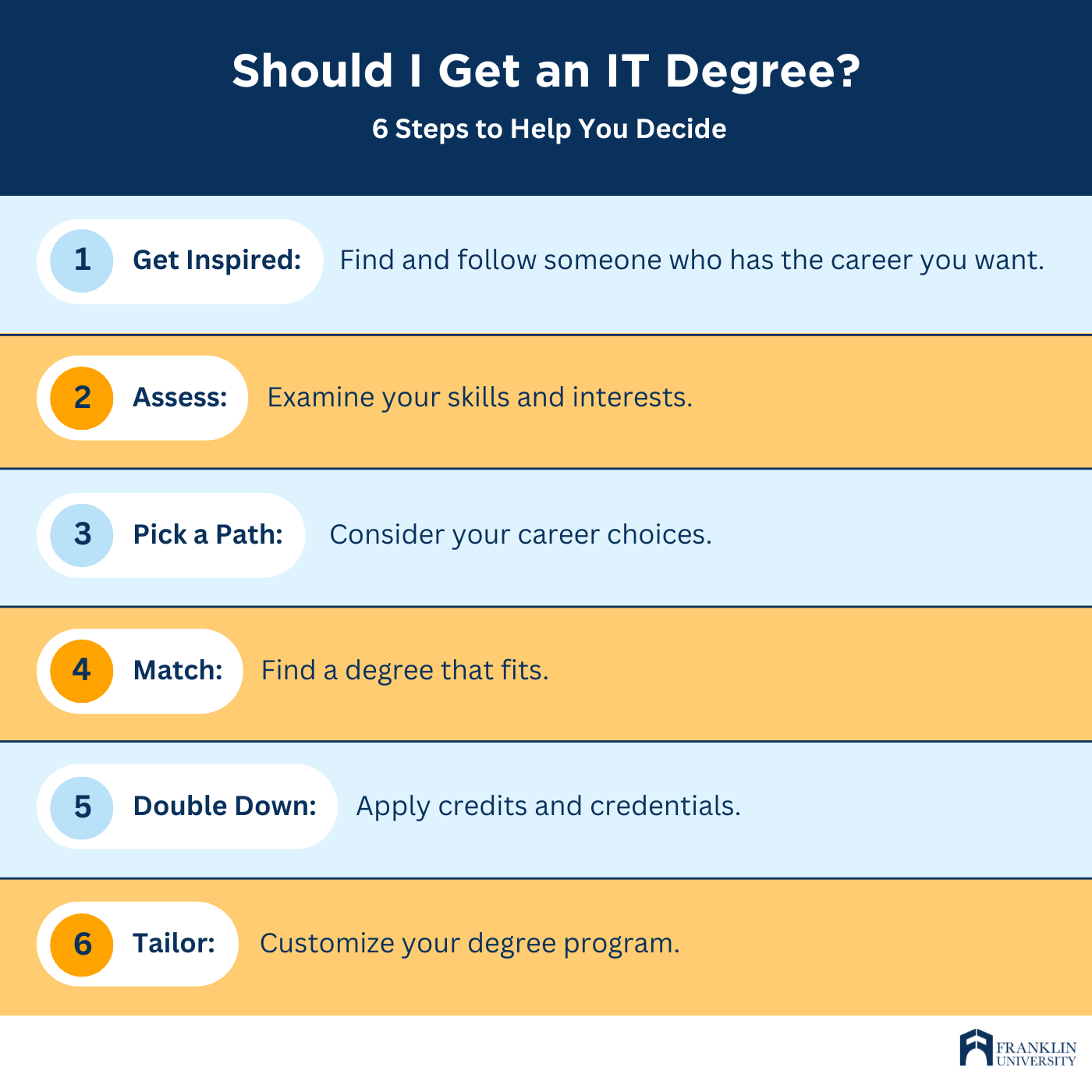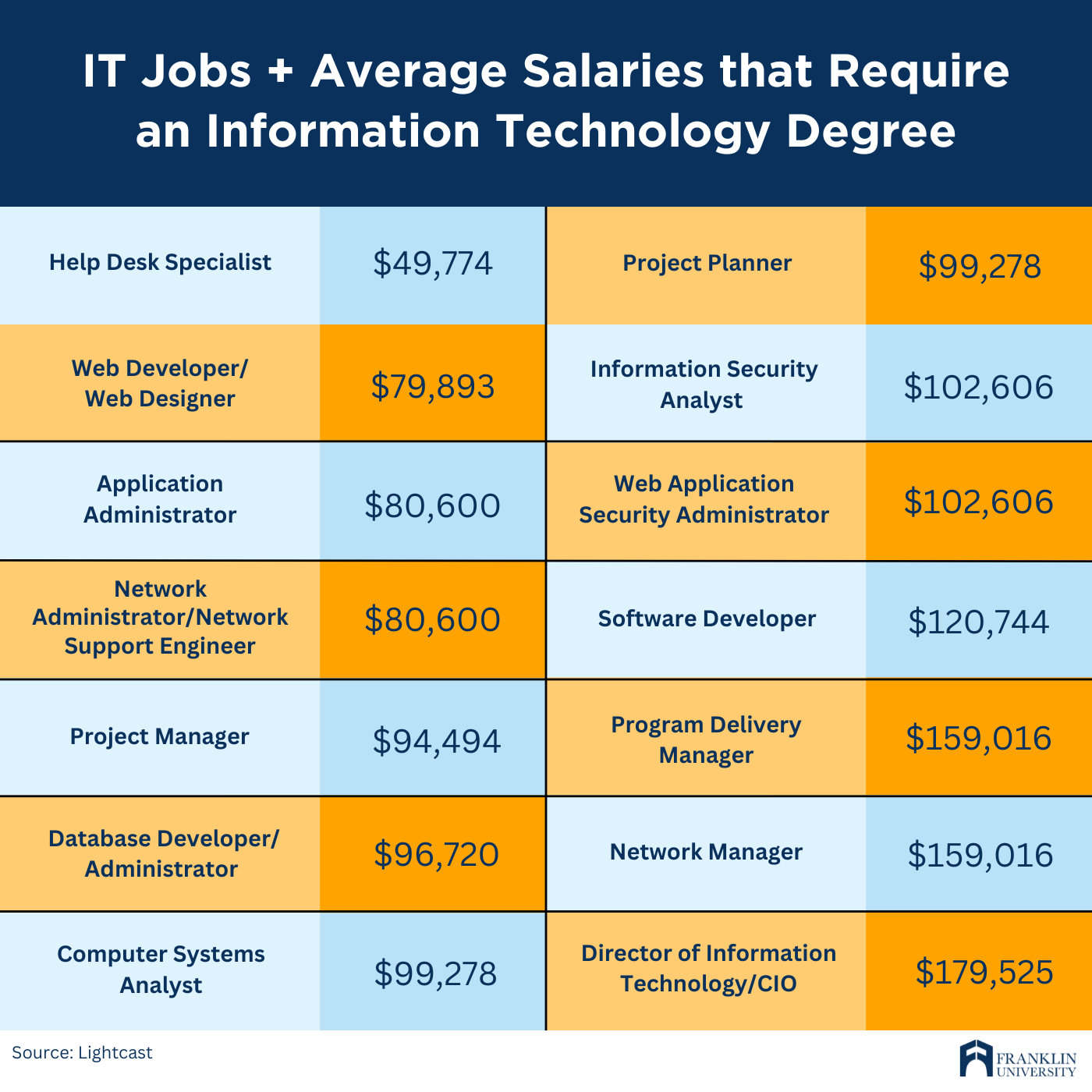Request Information
We're Sorry
There was an unexpected error with the form (your web browser was unable to retrieve some required data from our servers). This kind of error may occur if you have temporarily lost your internet connection. If you're able to verify that your internet connection is stable and the error persists, the Franklin University Help Desk is available to assist you at helpdesk@franklin.edu, 614.947.6682 (local), or 1.866.435.7006 (toll free).
Just a moment while we process your submission.

Is an Information Technology Degree Right for Me?
If you ask anyone with a career in information technology how they got into it, they’ll likely tell you, “I’ve been interested in technology for as long as I can remember.”
Even if you haven’t built a future-proof laptop or developed your own app, thinking about getting an information technology (IT) degree means there’s something about technology–and its place in the world–that appeals to you.
From infrastructure management to database administration to network and systems administration, an IT degree can prepare you for a career in one of the most challenging, rewarding and fast-paced fields of the 21st century.
Should I Get an IT Degree: 6 Steps to Help You Decide
Here are six steps you can take now to see if earning an IT degree is in your future.

Step 1: Find and follow someone who has the job you want.
Job shadowing can give you a big dose of reality, letting you know if you’re on the right track. This peek into the day-to-day workings of a real professional in a real-world work environment can help figure out what you really want from an IT career. Of course, if you’re already working in information technology, it’s still a good idea to do some pre-leveling up. How? By asking for a 1:1 informational interview with a person in an area of IT that’s different from yours. Prepare yourself for the meeting by doing a little homework first. Check out the person’s professional profile on social media, and also come up with a list of questions that you really want answered. Make sure to avoid “yes” and “no” questions and instead ask open-ended ones like, “What’s the most demanding part of your job?” or “How did you know an IT degree was right for you?”
When it comes to paying for school, grants are among your best options. But do you know how to find them? Remove the guesswork by downloading this free guide
Step 2: Examine your skills and interests. (Be honest!)
Are you good at abstract thinking? Do you get geeked about details? Can you make connections between things when others can’t, such as how a software application can further a business objective? IT is a broad-based field, requiring a variety of skills. Looking at your own skills and interests can help you see where you’ll excel. For example, if you’re analytical and like research, cybersecurity or data analytics could be right up your alley. On the other hand, if you’re a super-organizer and multi-tasking planner, maybe you’re better suited for IT project management. The point is, aligning your skills and interests with your degree can make you much more successful.
Step 3: Consider your career choices.
The job outlook for those with an IT degree is really good. In fact, the U.S. Bureau of Labor Statistics (BLS) predicts a 15% growth rate for computer and information technology jobs between now and 2031. That’s considerably faster than the 3% average for all occupations combined. But that’s not all. The BLS also says that the median annual wage for computer and IT jobs is $97,430. That’s a 112.9% increase over the median annual wage for all occupations, which is of $45,760
Step 4: Find a degree program that fits you and your life.
It can be tough to juggle work, family, friends and other commitments with going back to college. But it’s a whole lot easier when you enroll in a degree program from an accredited nonprofit university that’s built to fit your life. Don’t settle for just any IT degree, though. Look for a program that offers a convenient and affordable education along with 100% online classes and a flexible course schedule. That way, you can be sure you’ll finish what you start.
Step 5: Get credit for what you’ve earned and learned.
The path to an IT career can be a winding one. If you’ve already taken classes or earned a specialized certification, make sure to get credit where credit is due. Transfer credit or applied credit can help you finish faster. So, don’t be shy in asking if your degree program lets you apply eligible earned course credits, associate degree program credits or specialized certifications including these popular ones:
- Certified Cloud Security Professional (CISSP)
- Microsoft Certifications (Azure, Power Platforms, etc.)
- CompTIA Network+ or Cisco CCNA
- PMP® or CAPM®
- RHCE® or RHCSA
Step 6: Customize your degree and deepen your knowledge.
One of the best things about going back to school as an adult and earning your IT degree is that you can build your current skills and develop new ones. That’s why you might want to look for an information technology curriculum that covers a wide range of in-demand systems, programming languages and platforms, such as Ruby, Java, Python, JavaScript, C++ and PHP.
IT Jobs that Require an Information Technology Degree
Now, two final words before you decide if an IT degree is right for you: job prospects. There are hundreds and hundreds of potential jobs and career positions for IT grads. Here’s a list of some of the most popular IT jobs along with their median annual salary, according to Lightcast:

So, is an IT degree right for you?
Only you can answer that question. But these six steps should give you both the inspiration and information you need to feel confident in whatever decision you make.
Already decided that an IT degree is right for you?
Here’s a bonus step for you. Apply now to enroll in an IT degree program that prepares you for a cool career in a very hot industry.





